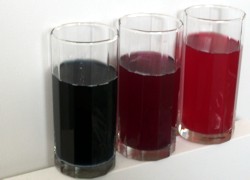pH Scale
Acids and Bases
The pH scale tells us the strength of an acid or a base, just like kilograms tells us how heavy an object is. Acids and bases are all around us, most liquids are either basic or acidic. Although distilled water has a pH of 7 meaning it is neutral.
Our Top Gift Ideas for Young Scientists
 |
  |
 |
|---|
'Science Kids'
Stay updated and subscribe to "Science News For Kids" our monthly e-zine.
Acids are generally considered as sour, for example lemon juice which contains citric acid. Back a couple hundred years ago people tasted substances to see if they were acid or basic. Although in a lab today you never ever put chemicals in your mouth. Instead of tasting them we can use indicators which change their colour to show us whether it’s a basic or an acidic solution. There are many types of indicators some only show whether a substance is basic or acidic like litmus paper and other show the pH such as universal indicator.
Bases usually have a soapy feel to them because when you touch them they react with the oils and fats. This reaction is referred to as saponification and soap is actually formed on your skin. Sometime bases are referred to alkalis. Alkaline are essentially bases, but it is a branching group which is soluble in water.
What is the pH scale?
The pH scale goes all the way from 1 which is very acidic to 14 which is very basic. Even though the scale does not go below one or over fourteen substances can still go below a pH level of one or over the pH of fourteen. The scale is just used as a reference point. In case you are wondering, pH stands for "potential hydrogen". This refers to the ability a substance has to attract hydrogen ions, or essentially the balance between alkaline and acid.
The reason acids are acidic is because they have more hydrogen ions than hydroxide ions which make a solution basic. This is why acids are on the lower end of the pH scale from 7 down wards. It already has lot of hydrogen ions and hydrogen ions don’t attract hydrogen ions so it shows up as having a low pH level. In a basic solution there are not a lot of hydrogen ions if any. Instead a basic solution contains hydroxide ions which attract hydrogen ions.
When you mix an acid with base they start to neutralise each other. When a hydrogen ion bonds with a hydroxide ion and it forms water which has a pH of 7 which is neutral. The other result of mixing an acid with a base is salt. For example when you mix sulphuric acid with sodium hydroxide you get water and sodium sulphate. If you mix hydrochloric acid with sodium hydroxide you get water and sodium chloride. Sodium chloride is actually the scientific name for normal table salt.
Acids and bases in the body
Acids and bases actually play very important roles in our lives. Did you know your stomach contains a very powerful acid called hydrochloric acid which has a very low pH? This acid solution aids in food digestion, but it also acts as a defence. This low pH inhibits or kills bacteria protecting you from all the bacteria you ingest daily. Hydrochloric acid can also dissolve metals and even the strongest substance in your body, enamel. The enamel in your teeth is very strong, but stomach acid can dissolve it.
Share your experiment related to this topic.
Do you have a great experiment or experience related to this page that you would like to share? Share it!
Go back from "pH Scale" experiments to the home.
